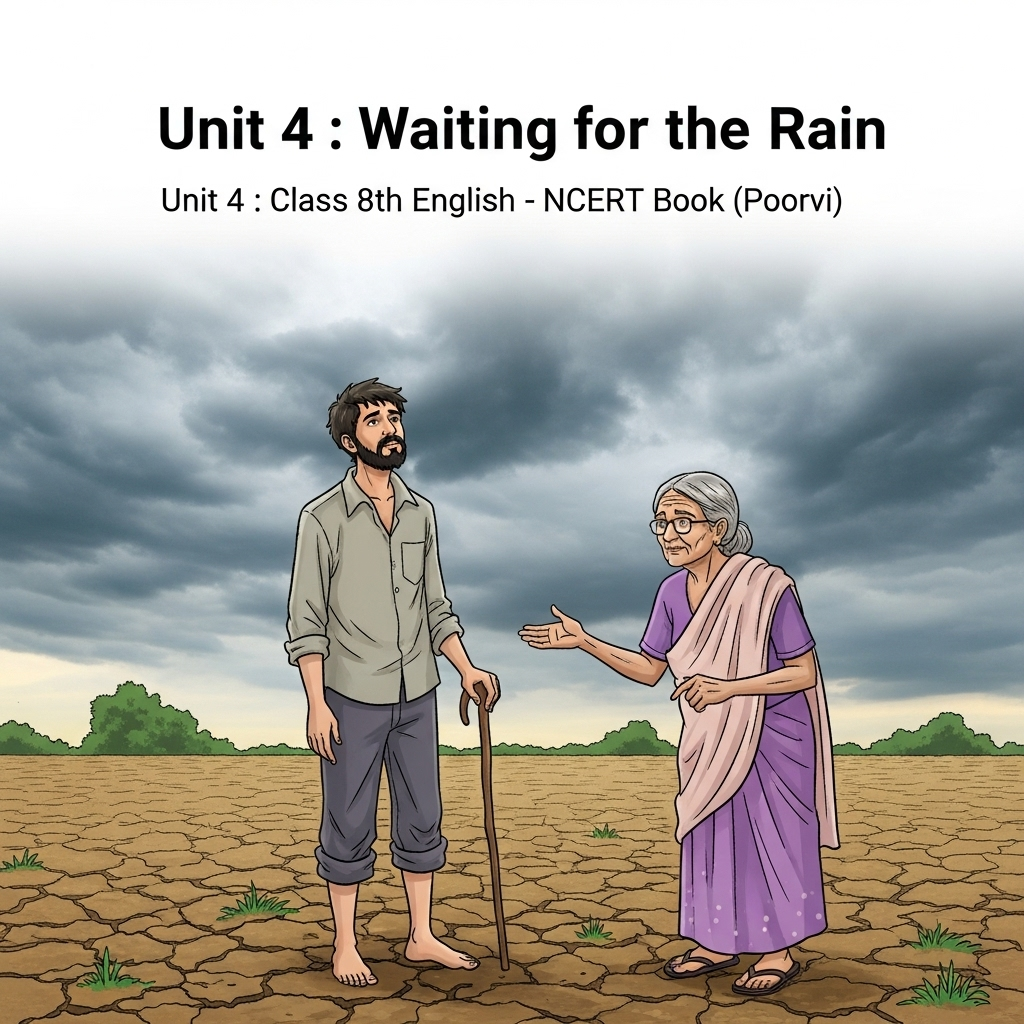Complete Solutions and Summary – Waiting for Rain – NCERT Class 8, English, Unit 4 – Summary, Questions, Answers, Extra Questions
Detailed summary and explanation of Unit 4 ‘Waiting for Rain’ with all question answers, extra questions, and solutions from NCERT Class VIII English (Poorvi).
Updated: 2 months ago

Introduction
"Waiting for the Rain" is a poignant story about Velu, a hardworking farmer facing a severe drought that threatens his livelihood. Throughout his anxious wait for rain, Velu encounters a wise old woman who teaches him an important lesson about the earth’s need for rest and natural balance. The story goes beyond the immediate difficulty, illuminating respect for nature’s rhythms and sustainable farming practices, emphasizing patience, hope, and harmony with the environment.
Summary in English (200 words):
Velu, whose land has always yielded crops, faces a season without rain. Despite consulting astrologers and weather offices, no solution comes. An old woman advises him that the earth, too, needs rest to regain strength. Velu understands and accepts this wisdom. Soon, the rain begins, renewing hope and life. The story demonstrates the importance of ecological balance and patience amid hardship.
Summary in Hindi (200 words):
वेलु, एक मेहनती किसान, इस बार वर्षा के बिना फसल बोने की परेशानी से गुजर रहा है। उसने ज्योतिषी और मौसम कार्यालय से सलाह ली, लेकिन कोई मदद नहीं मिली। एक बुजुर्ग महिला ने उसे बताया कि पृथ्वी को भी आराम की जरूरत होती है ताकि वह फिर से ताकत हासिल कर सके। वेलु ने यह बात समझी और स्वीकार किया। जल्द ही बारिश आने लगी, जिससे उम्मीद और जीवन लौट आया। कहानी प्रकृति के संतुलन और धीरज रखने का महत्व बताती है।
Thinking about the chapter – Waiting for Rain
-
1. Who is Velu and what challenge is he facing in the story?
Velu is a hardworking farmer facing a severe drought, as the rains have failed to arrive, causing his fields to become barren.
-
2. How do Velu and his neighbors try to find a solution to the drought?
The villagers consider consulting astrologers to know what might please the heavens and bring rain.
-
3. What was the response of the weather office when Velu inquired about the rain?
Officials said they could not predict when the rain would come despite favorable conditions, expressing uncertainty.
-
4. What advice does the old woman give to Velu about farming and the earth?
She advises that the earth needs rest and should be left fallow at times to regain its strength for future crops.
-
5. How does the story depict the emotional state of Velu during the drought?
Velu feels tired, dejected, and worried about the future, showing the emotional burden the drought places on farmers.
-
6. What natural signs show that the rain is about to come at the end of the story?
Clouds gather, the sky grows dark, and there are signs of lightning and thunder, indicating imminent rain.
-
7. Why does the old woman say that the land needs rest?
She explains that continuous farming exhausts the land, and resting allows the soil to recover nutrients and moisture.
-
8. How does Velu's understanding of nature change after his conversation with the old woman?
Velu realizes the importance of working in harmony with nature by allowing the land to rest and trusting natural cycles.
-
9. What role does hope play in the story "Waiting for Rain"?
Hope sustains Velu and the villagers through the drought, keeping them optimistic for the rains despite uncertainty.
-
10. What message about sustainable farming does the story convey?
The story highlights the need for sustainable practices like fallowing to preserve soil health and ensure long-term productivity.
Detailed Questions – Waiting for Rain
-
1. Explain the symbolism of rain in the story and its significance to the farmers.
Rain symbolizes life, hope, and renewal. It represents the end of hardship and the beginning of abundance, crucial for farming and the survival of the villagers, emotionally and physically rejuvenating them and the land.
-
2. Discuss how the story portrays the relationship between humans and nature.
The story shows a reciprocal relationship where humans depend on nature for sustenance but must also respect and care for it by allowing the land to rest for continued fertility and productivity.
-
3. How does the advice given by the old woman reflect traditional ecological wisdom?
The old woman's advice embodies indigenous knowledge about sustainable farming, emphasizing the importance of resting the land to maintain soil health and prevent ecological damage caused by continuous cultivation.
-
4. Analyze how the story represents the struggles of farmers during adverse natural conditions.
The narrative highlights the relentless hard work, anxiety, and emotional toll farmers endure during droughts while balancing faith in nature and the uncertainty of weather that impacts their livelihoods.
-
5. What lessons about patience and resilience can be learned from "Waiting for Rain"?
The story teaches that patience and trust in nature's cycles are essential. Despite hardship and waiting, resilience and hope help sustain farmers until nature itself restores balance.

Group Discussions
No forum posts available.


